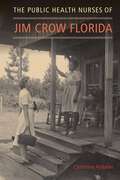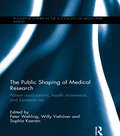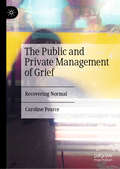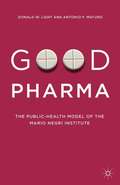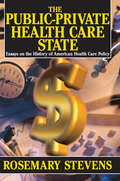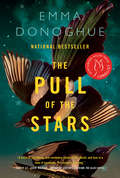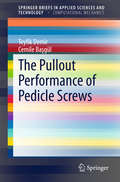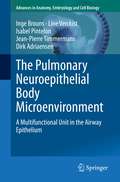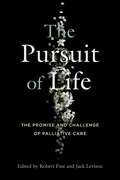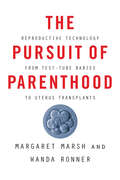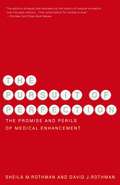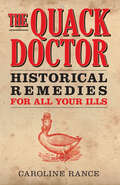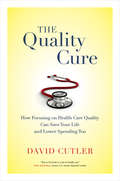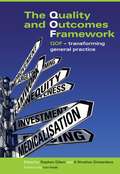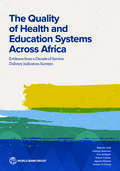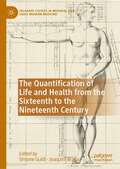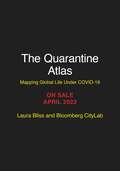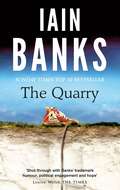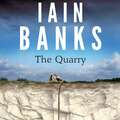- Table View
- List View
The Public Health Nurses of Jim Crow Florida
by Christine ArdalanFlorida Historical Society Harry T. and Harriette V. Moore Award Highlighting the long unacknowledged role of a group of pioneering professional women, The Public Health Nurses of Jim Crow Florida tells the story of healthcare workers who battled racism in a state where white supremacy formed the bedrock of society. They aimed to serve those people out of reach of modern medical care. In the era of Jim Crow discrimination, their marginalization in medical facilities—along with the overall medical neglect to address their health—meant that many African Americans in rural communities rarely saw doctors. Christine Ardalan shows how Florida’s public health nurses took up the charge, traveling into the Florida scrub to deliver health improvement information to the homes of Black and white residents, many of whom were illiterate. Drawing on a rich body of public health and nursing records, Ardalan draws attention to the innovative ways nurses bridged the gap between these communities and government policies that addressed threats of infection and high rates of infant and maternal mortality. From the progressive era to the civil rights movement, Florida’s public health nurses worked to overcome the constraints of segregation. Their story is echoed by the experiences of today’s community health nurses, who are keenly aware that maintaining healthy lives for all Americans requires tackling the nation’s deep-rooted cultural challenges.
The Public Private Mix for Health
by Alan MaynardRecent changes to the health service including new structures and ways of working at both local and national levels are having major influences on the working lives of every health visitor and community nurse and on their professional opportunities. Understanding these changes is essential and this practical and authoritative handbook addresses them all. The authors all have first-hand experience of the radical changes underway. The clear straightforward format is designed to allow quick access to relevant and up-to-date information. The book is vital reading for every community practitioner.
The Public Shaping of Medical Research: Patient Associations, Health Movements and Biomedicine
by Peter Wehling Willy Viehöver Sophia KoenenPatient organizations and social health movements offer one of the most important and illuminating examples of civil society engagement and participation in scientific research and research politics. Influencing the research agenda, and initiating, funding and accelerating the development of diagnostic tools, effective therapies and appropriate health-care for their area of interest, they may champion alternative, sometimes controversial, programs or critique dominant medical paradigms. Some movements and organizations advocate for medical recognition of contested illnesses, as with fibromyalgia orADHD, while some attempt to "de-medicalize" others, such as obesity or autism.Bringing together an international selection of leading scholars and representatives from patients' organizations, this comprehensive collection explores the interaction between civil society groups and biomedical science, technology development, and research politics. It takes stock of the key findings of the research conducted in the field over the past two decades and addresses emerging problems and future challenges concerning the interrelations between health movements and patient organisations on the one hand, and biomedical research and research policies on the other hand. Combining empirical case studies with conceptual discussion, the book discusses how public participation can contribute to, as well as restrict, the democratization of scientific knowledge production.This volume is an important reference for academics and researchers with an interest in the sociology of health and illness, science and technology studies, the sociology of knowledge, medical ethics or healthcare management and research, as well as medical researchers and those involved with health-related civil society organizations.
The Public and Private Management of Grief: Recovering Normal
by Caroline PearceThrough a critical analysis of theory, policy and practice, The Public and Private Management of Grief looks at how 'recovery' is the prevailing discourse that measures and frames how people grieve, and considers what happens when people 'fail' to recover. Pearce draws on in-depth interviews with bereaved people and a range of bereavement professionals, to contemplate how ‘failures’ to recover are socially perceived and acted upon. Grounded in Foucauldian theory, this book problematises the notion of recovery, and instead argues for the acknowledgment of the experience of ‘non-recovery,’ highlighting how recovery is a socially and historically constructed notion linked to the individualised vision of health and happiness promoted by neo-liberal governmentality. This book will be of interest to students and scholars across sociology, anthropology, social work and psychology with a focus on death, dying and bereavement, grief studies, health and social care, as well as counsellors, clinical psychologists and social workers.
The Public-Health Model of the Mario
by Donald W. Light Antonio F. MaturoDrawing on key concepts in sociology and management, this history describes a remarkable institute that has elevated medical research and worked out solutions to the troubling practices of commercial pharmaceutical research. Good Pharma is the answer to Goldacre's Bad Pharma : ethical research without commercial distortions.
The Public-private Health Care State: Essays on the History of American Health Care Policy
by Rosemary A. StevensThe distinctive mixing and continuous remixing of public and private roles is a defining feature of health care in the United States. The Public-Private Health Care State explores the interweaving of public and private enterprise in health care in the United States as a basis for thinking about health care in terms of its history and its continuing evolution today. Historian and policy analyst Rosemary Stevens has selected and edited seventeen essays from both her published and unpublished work to illustrate continuing themes, such as: the flexible meanings of the terms public and private, and how useful their ambiguity has been and is; the role of ideology as ratifying rather than preordaining change; and the common behavior of public leaders and corporate entities in the face of fiscal opportunity. The topics--covering the period of 1870 through the twenty-first century--represent Stevens' research interests in hospital history and policy, the medical profession, government policy, and paying for health care. The volume also considers her involvement with policy questions, which include health services research, health maintenance organizations, and physician workforce policy. Section I demonstrates the long history of state government involvement with private not-for-profit hospitals from the 1870s through the 1930s. Section II examines the federal role in health care from the 1920s through the 1970s, including the establishment of veterans' hospitals and the implementation of Medicaid. Section III shows how shifting governmental roles require constantly changing organizing rhetoric, whether for inventing a federal role for health services research and HMOs, regionalization in the 1970s, or defining civil rights and equity as mobilizing vehicles in the 1980s. Section IV examines growing concerns from the 1970s through the present about the traditional public role of the largely private medical profession. Section V returns to the ambiguous public-priv
The Pueblo Revolt and the Mythology of Conquest: An Indigenous Archaeology of Contact
by Michael V. WilcoxMichael V. Wilcox upends many deeply held assumptions about native peoples in North America. His provocative book poses the question, What if we attempted to explain their presence in contemporary society five hundred years after Columbus instead of their disappearance or marginalization?
The Pull of the Stars: A Novel
by Emma DonoghueDublin, 1918: three days in a maternity ward at the height of the Great Flu. <P><P>A small world of work, risk, death and unlooked-for love, by the bestselling author of The Wonder and ROOM. <P><P>In an Ireland doubly ravaged by war and disease, Nurse Julia Power works at an understaffed hospital in the city center, where expectant mothers who have come down with the terrible new Flu are quarantined together. Into Julia’s regimented world step two outsiders—Doctor Kathleen Lynn, on the run from the police, and a young volunteer helper, Bridie Sweeney. <P><P> In the darkness and intensity of this tiny ward, over three days, these women change each other’s lives in unexpected ways. They lose patients to this baffling pandemic, but they also shepherd new life into a fearful world. <P><P>With tireless tenderness and humanity, carers and mothers alike somehow do their impossible work. In The Pull of the Stars, Emma Donoghue once again finds the light in the darkness in this new classic of hope and survival against all odds.
The Pull of the Stars: A Novel
by Emma DonoghueIn Dublin, 1918, a maternity ward at the height of the Great Flu is a small world of work, risk, death, and unlooked-for love, in "Donoghue's best novel since Room" (Kirkus Reviews). <p><p> In an Ireland doubly ravaged by war and disease, Nurse Julia Power works at an understaffed hospital in the city center, where expectant mothers who have come down with the terrible new Flu are quarantined together. Into Julia's regimented world step two outsiders -- Doctor Kathleen Lynn, a rumoured Rebel on the run from the police , and a young volunteer helper, Bridie Sweeney. In the darkness and intensity of this tiny ward, over three days, these women change each other's lives in unexpected ways. They lose patients to this baffling pandemic, but they also shepherd new life into a fearful world. With tireless tenderness and humanity, carers and mothers alike somehow do their impossible work. In The Pull of the Stars, Emma Donoghue once again finds the light in the darkness in this new classic of hope and survival against all odds.
The Pullout Performance of Pedicle Screws
by Teyfik Demir Cemile BasgülThis brief book systematically discusses all subjects that affect the pullout strength of pedicle screws. These screws are used in spinal surgeries to stabilize the spine. The holding strength of the pedicle screw is vital since loosening of the pedicle screws can cause revision surgeries. Once the pedicle screw is pulled out, it is harder to obtain same stabilization for the fused vertebrae. The book reviews the effect of screw designs, application techniques, cement augmentation, coating of the screw and test conditions on the pullout strength. The studies with finite element analysis were also included.
The Pulmonary Neuroepithelial Body Microenvironment: A Multifunctional Unit in the Airway Epithelium (Advances in Anatomy, Embryology and Cell Biology #233)
by Isabel Pintelon Dirk Adriaensen Jean-Pierre Timmermans Inge Brouns Line VerckistThis monograph sheds new light on pulmonary sensory receptors. Diving into the pulmonary microenvironment, the book focuses on the role of pulmonary neuroepithelial bodies (NEBs) as potential receptors and effectors, able to store and release neurotransmitters. It explores NEBs as potential stem cell niche and highlights the multidisciplinary approach taken to identify and study NEBs, including functional morphological investigation, live cell imaging, genetic models, and laser microdissection combined with gene expression analysis.Complexly organized NEBs are an integral part of the intrapulmonary airway epithelium of all air-breathing vertebrates. For decades a quest has been going on to unravel the functional significance of these intriguing structures that appear to be modified in the course of many pulmonary diseases. The NEB microenvironment (ME) is composed of organoid clusters of pulmonary neuroendocrine cells (PNECs) that are able to store and release neurotransmitters and are closely contacted by extensive nerve terminals, emphasizing a potential receptor/effector role and probable signalling to the central nervous system. PNECs are largely shielded from the airway lumen by a special type of Clara cells, the Clara-like cells, with potential stem cell characteristics. So far, functional studies of the pulmonary NEB ME revealed that PNECs can be activated by various mechanical and chemical stimuli, resulting in a calcium-mediated release of neurotransmitters. In the past decades, a number of publications have exposed NEBs as potential hypoxia sensors. Recent experimental evidence unveiled that the NEB ME is a quiescent stem cell niche in healthy postnatal lungs, and silencing may involve bone morphogenetic protein signalling mediated by vagal afferents. Only an integrated approach that takes all current information into account will be able to explain the full role of the pulmonary NEB ME in health and disease. This highly informative and carefully presented book, provides insights for researchers, PhD students with an interest in (bio)medical and veterinary science, especially in the field of the autonomic innervation of the lung, chemo-and mechanoreceptors
The Pursuit of Happiness in America: A Sociological Perspective
by Brian J. JonesEverybody wants to know what makes people happy. Artistic takes on the topic in literature, popular songs and cinema are widespread, but not terribly helpful. Psychological accounts are mostly about how to avoid unhappiness. So who actually is happy, and why? This book offers real answers from the real world of American society. Their source is the General Social Survey, a scientific poll of Americans offering some five decades of state-of-the-art data. An additional enhancement is a set of qualitative interviews commissioned by the author adding depth to the extraordinary breadth of the GSS. The approach of the book is distinctly sociological. Are married Americans happier than unmarried Americans? Does social class matter? How about college? The answers lie within this wide and deep dive into happiness in America.
The Pursuit of Life: The Promise and Challenge of Palliative Care
by Robert Fine, Jack Levison and Kelsey SpinnatoThis volume examines crucial concerns in palliative care, including the proper balance between comfort and cure for the patient, the integration of spiritual well-being, and the challenges of providing care in the absence of basic medical services and supplies.In the first section, palliative-care pioneers Constance Dahlin, Eduardo Bruera, Neil MacDonald, and Declan Walsh recount the early history of the discipline. Part 2 discusses the role of poetry, prose, plays, and other aspects of the humanities in the practice of palliative care. Part 3 explores essential current issues in the field, including autonomy, the use of opioids, and the impact of artificial intelligence on the evolution of palliative care. The final section focuses on the spiritual dimensions of pain and suffering.Rich with anecdotes and personal stories and featuring contributions from pioneers and current practitioners, The Pursuit of Life is an essential assessment of the past, present, and future of palliative care. In addition to the editors, the contributors include W. Andrew Achenbaum, Stacy L. Auld, Elena Pagani Bagliacca, Costantino Benedetti, Courtenay Bruce, Eduardo Bruera, Joseph Calandrino, Jim Cleary, Constance Dahlin, Andrea Ferrari, Mauro Ferrari, Joseph J. Fins, Bettie Jo Tennon Hightower, Kathryn B. Kirkland, Robin W. Lovin, Neil MacDonald, Charles Millikan, Dominique J. Monlezun, Tullio Proserpio, Giovanna Sironi, Daniel P. Sulmasy, and Declan Walsh.
The Pursuit of Parenthood: Reproductive Technology from Test-Tube Babies to Uterus Transplants
by Margaret Marsh Wanda RonnerA wide-ranging history of assisted reproductive technologies and their ethical implications.Finalist of the PROSE Award for Best Book in History of Science, Medicine and Technology by the Association of American PublishersSince the 1978 birth of the first IVF baby, Louise Brown, in England, more than eight million children have been born with the help of assisted reproductive technologies. From the start, they have stirred controversy and raised profound questions: Should there be limits to the lengths to which people can go to make their idea of family a reality? Who should pay for treatment? How can we ensure the ethical use of these technologies? And what can be done to address the racial and economic disparities in access to care that enable some to have children while others go without?In The Pursuit of Parenthood, historian Margaret Marsh and gynecologist Wanda Ronner seek to answer these challenging questions. Bringing their unique expertise in gender history and women's health to the subject, Marsh and Ronner examine the unprecedented means—liberating for some and deeply unsettling for others—by which families can now be created. Beginning with the early efforts to create embryos outside a woman's body and ending with such new developments as mitochondrial replacement techniques and uterus transplants, the authors assess the impact of contemporary reproductive technology in the United States. In this volume, we meet the scientists and physicians who have developed these technologies and the women and men who have used them. Along the way, the book dispels a number of fertility myths, offers policy recommendations that are intended to bring clarity and judgment to this complicated medical history, and reveals why the United States is still known as the "Wild West" of reproductive medicine.
The Pursuit of Perfection: The Promise and Perils of Medical Enhancement
by David Rothman Sheila RothmanWhat does it mean to live in a time when medical science can not only cure the human body but also reshape it? How should we as individuals and as a society respond to new drugs and genetic technologies? Sheila and David Rothman address these questions with a singular blend of history and analysis, taking us behind the scenes to explain how scientific research, medical practice, drug company policies, and a quest for peak performance combine to exaggerate potential benefits and minimize risks. They present a fascinating and factual story from the rise of estrogen and testosterone use in the 1920s and 1930s to the frenzy around liposuction and growth hormone to the latest research into the genetics of aging. The Rothmans reveal what happens when physicians view patients' unhappiness and dissatisfaction with their bodies--short stature, thunder thighs, aging--as though they were diseases to be treated. The Pursuit of Perfection takes us from the early days of endocrinology (the belief that you are your hormones) to today's frontier of genetic enhancements (the idea that you are your genes). It lays bare the always complicated and sometimes compromised positions of science, medicine, and commerce. This is the book to read before signing on for the latest medical fix.From the Hardcover edition.
The Putting Patients First Field Guide: Global Lessons in Designing and Implementing Patient-Centered Care (Jossey-Bass Public Health #216)
by Planetree Foundation"This book answers 'why not' and 'how to' for health care accreditation bodies, quality experts, and frontline professionals, moving the reader from timely information, to inspiration, and through patient-centered action with practical tools and potent case studies." —Paul vanOstenberg, DDS, MS, vice president, Accreditation and Standards, Joint Commission International "This superb guide from Planetree illustrates that providing high-quality, high-value, patient-centered health care is not a theoretical ideal. The case studies make clear that these goals are attainable; they are being achieved by leading health care organizations worldwide, and there is a clear road map for getting there—right here in this book." —Susan Dentzer, senior policy adviser to the Robert Wood Johnson Foundation "At IHI, we follow the principle, 'all teach, all learn'—the idea that everyone, everywhere has something to teach, and something to learn. This remarkable and indispensable guide is as pure an example of this principle as I've come across." —Maureen Bisognano, president and chief executive officer, Institute for Healthcare Improvement "The International Society for Quality in Health Care's mission is to inspire, promote, and support continuous improvement in the quality and safety of health care worldwide. It is in this spirit that we welcome this new book on patient-centered care. As in their previous work, the authors demonstrate just how critical it is to develop an organizational culture that puts patients first." —Peter Carter, chief executive officer, International Society for Quality in Health Care
The Quack Doctor: Historical Remedies For All Your Ills
by Caroline RanceFrom the harangues of charlatans to the sophisticated advertising of the Victorian era, quackery sports a colourful history. Featuring entertaining advertisements from the nineteenth and early twentieth centuries, this book investigates the inventive ways in which quack remedies were promoted – and suggests that the people who bought them should not be written off as gullible after all. There’s the Methodist minister and his museum of intestinal worms, the obesity cure that turned fat into sweat, and the device that brought the fresh air of Italy into British homes. The story of quack advertising is bawdy, gruesome, funny and sometimes moving – and in this book it takes to the stage to promote itself as a fascinating part of the history of medicine.
The Quality Cure
by David CutlerIn the United States, the soaring cost of health care has become an economic drag and a political flashpoint. Moreover, although the country's medical spending is higher than that of any other nation, health outcomes are no better than elsewhere, and in some cases are even worse. In The Quality Cure, renowned health care economist and former Obama advisor David Cutler offers an accessible and incisive account of the issues and their causes, as well as a road map for the future of health care reform--one that shows how information technology, realigned payment systems, and value-focused organizations together have the power to resolve this seemingly intractable problem and transform the US health care system into one that is affordable, efficient, and effective.
The Quality Improvement Challenge: A Practical Guide for Physicians
by Richard J. Banchs Michael R. PopEfforts to improve the quality of healthcare have failed to achieve a meaningful and sustainable improvement. Patients continue to experience fragmented, inconvenient, and unsafe care while providers are increasingly becoming overburdened with administrative tasks. The need for change is clear. Healthcare professionals need to take on new leadership roles in quality improvement (QI) projects to effect real change. The Quality Improvement Challenge in Healthcare equips readers with the skills and knowledge required to develop and implement successful operational improvement initiatives. Designed for healthcare providers seeking to apply QI in practice, this valuable resource delivers step-by-step guidance on improvement methodology, team dynamics, and organizational change management in the context of real-world healthcare environments. The text integrates the principles and practices of Lean Six Sigma, human-centered design, and neurosciences to present a field-tested framework. Detailed yet accessible chapters cover topics including identifying and prioritizing the problem, developing improvement ideas, defining the scope of the project, organizing the QI team, implementing and sustaining the improvement, and much more. Clearly explaining each step of the improvement process, this practical guide: Presents the material in a logical sequence, gradually introducing each step of the process with clearly defined workflow templates Features a wealth of examples demonstrating QI application, and case studies emphasizing key concepts to highlight successful and unsuccessful improvement initiatives Includes end-of-chapter exercises and review questions for assessing and reinforcing comprehension Offers practical tips and advice on communicating effectively, leading a team meeting, conducting a tollgate review, and motivating people to change Leading QI projects requires a specific set of skills not taught in medical school. The Quality Improvement Challenge in Healthcare bridges this gap for experienced and trainee healthcare providers, and serves as an important reference for residency program directors, physician educators, healthcare leaders, and health-related professional organizations.
The Quality and Outcomes Framework: QOF - Transforming General Practice
by Stephen Gillam Niro SiriwardenaThe Quality and Outcomes Framework has deeply divided UK general practitioners. I commend this book and applaud its determination to scrutinise every aspect of the Quality and Outcomes Framework - good and bad and in-between. - From the Foreword by Iona Heath General practice in the UK faces transformation following the introduction of the Quality & Outcomes Framework (QOF), a pay-for-performance scheme unprecedented in the NHS, and the most comprehensive scheme of its kind in the world. Champions claim the QOF advances the quality of primary care; detractors fear the end of general practice as we know it. The introduction of the QOF provides a unique opportunity for research, analysis and reflection. This book is the first comprehensive analysis of the impact of the QOF, examining the claims and counter-claims in depth through the experience of those delivering QOF, comparisons with other countries, and analysis of the wealth of research evidence emerging. Assessments of the true impact of QOF will influence the development of health services in the UK and beyond. This book is essential reading for anyone with an interest in the future of general practice and primary care, including health professionals, trainers, students, MRCGP candidates and researchers, managers, and policy-makers and shapers.
The Quality of Health and Education Systems Across Africa: Evidence from a Decade of Service Delivery Indicators Surveys
by Roberta Gatti Kathryn Andrews Ciro Avitabile Conner Andres Yi ChangHave teachers mastered the subject matter they are teaching? Can doctors accurately diagnose and treat critical health conditions? Are schools and health facilities sufficiently stocked with needed equipment and supplies? Are they sufficiently supported and staffed to optimize learning and health care outcomes? For the past decade, the World Bank’s Service Delivery Indicators (SDI) surveys have collected nationally representative data in countries across Sub-Saharan Africa to answer these questions. The surveys aim to measure the quality of services where they meet citizens: in schools and health facilities. The Quality of Health and Education Systems Across Africa: Evidence from a Decade of Service Delivery Services Indicators identifies areas of achievement and constraint in service delivery, shedding light on how service delivery may foster or stunt human capital accumulation. SDI surveys show that schools and health clinics across Africa are still falling short in some critical areas.The delivery of primary care services is very heterogenous between and within countries. Many health facilities lack the basic necessities to provide proper care, such as essential medicines, basic diagnostic equipment, and adequate water and sanitation. Moreover, health care providers’ ability to diagnose and treat common health conditions correctly is low and distributed unevenly. Health personnel’s absence from health facilities remains a concern across the surveyed countries. Learning is low, and, not unlike health care, levels of student learning vary significantly across countries: less than half of grade 4 students can recite a simple sentence or perform basic mathematical operations. This deficient learning is correlated with teachers’ low levels of content knowledge and sub-par pedagogy skills. Some schools are also missing crucial inputs, such as blackboards or private and gendered toilets, and struggle with high pupil-teacher ratios. Despite these challenges, success stories in both sectors illustrate the quality of service delivery that could be achieved and showcase the dedication of teachers and medical staff across Africa. By studying data from thousands of facilities, considering the local context, and drawing insights from the literature, this book offers important insights for how countries can strengthen health and education systems and build back better in the wake of the massive disruptions brought about by the COVID-19 pandemic.
The Quantification of Life and Health from the Sixteenth to the Nineteenth Century: Intersections of Medicine and Philosophy (Palgrave Studies in Medieval and Early Modern Medicine)
by Joaquim Braga Simone GuidiThis edited volume explores the intersection of medicine and philosophy throughout history, calling attention to the role of quantification in understanding the medical body. Retracing current trends and debates to examine the quantification of the body throughout the early modern, modern and early contemporary age, the authors contextualise important issues of both medical and philosophical significance, with chapters focusing on the quantification of temperaments and fluids, complexions, functions of the living body, embryology, and the impact of quantified reasoning on the concepts of health and illness. With insights spanning from the sixteenth century to the nineteenth century, this book provides a wide-ranging overview of attempts to ‘quantify’ the human body at various points. Arguing that medicine and philosophy have been constantly in dialogue with each other, the authors discuss how this provided a strategic opportunity both for medical thought and philosophy to refine and further develop. Given today’s fascination with the quantification of the body, represented by the growing profusion of self-tracking devices logging one’s sleep, diet or mood, this collection offers an important and timely contribution to an emerging and interdisciplinary field of study.
The Quarantine Atlas: Mapping Global Life Under COVID-19
by Laura Bliss A Bloomberg CityLab ProjectThe Quarantine Atlas is a poignant and deeply human collection of more than 65 homemade maps created by people around the globe that reveal how the coronavirus pandemic has transformed our physical and emotional worlds, in ways both universal and unique. Along with eight original essays, it is a vivid celebration of wayfinding through a crisis that irrevocably altered the way we experience our environment.In April 2020, Bloomberg CityLab journalists Laura Bliss and Jessica Lee Martin asked readers to submit homemade maps of their lives during the coronavirus pandemic. The response was illuminating and inspiring. The 400+ maps and accompanying stories received served as windows into what individuals around the world were experiencing during the crisis and its resonant social consequences. Collectively, these works showed how coronavirus has transformed the places we live, and our relationships to them.In The Quarantine Atlas, Bliss distills these stunning submissions and pairs them with essays by journalists and authors, as well as notes from the original mapmakers. The result is an enduring visual record of this unprecedented moment in human history. It is also a celebration of the act of mapping and the ways maps can help us connect and heal from our shared experience.
The Quarry
by Iain BanksKit doesn't know who his mother is. What he does know, however, is that his father, Guy, is dying of cancer. Feeling his death is imminent, Guy gathers around him his oldest friends - or at least the friends with the most to lose by his death. Paul - the rising star in the Labour party who dreads the day a tape they all made at university might come to light; Alison and Robbie, corporate bunnies whose relationship is daily more fractious; Pris and Haze, once an item, now estranged, and finally Hol - friend, mentor, former lover and the only one who seemed to care. But what will happen to Kit when Guy is gone? And why isn't Kit's mother in the picture? As the friends reunite for Guy's last days, old jealousies, affairs and lies come to light as Kit watches on.
The Quarry
by Iain BanksKit doesn't know who his mother is. What he does know, however, is that his father, Guy, is dying of cancer. Feeling his death is imminent, Guy gathers around him his oldest friends - or at least the friends with the most to lose by his death. Paul - the rising star in the Labour party who dreads the day a tape they all made at university might come to light; Alison and Robbie, corporate bunnies whose relationship is daily more fractious; Pris and Haze, once an item, now estranged, and finally Hol - friend, mentor, former lover and the only one who seemed to care. But what will happen to Kit when Guy is gone? And why isn't Kit's mother in the picture? As the friends reunite for Guy's last days, old jealousies, affairs and lies come to light as Kit watches on.
